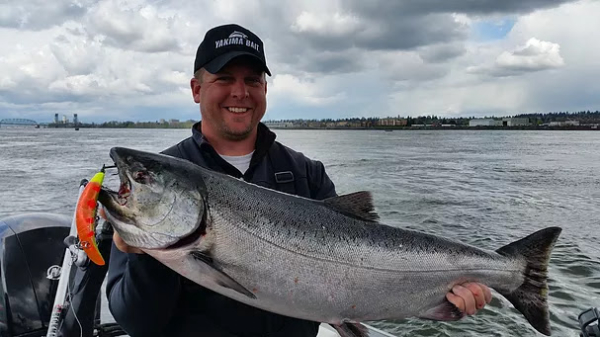Fishing Flatfish for Fall Salmon |
| by Yakima Pro Cody Herman from The Fishing Wire As the nights become cooler and the rains begin to fall, salmon begin their upward migration to the waters where they were born in hopes of creating future generations. These crisp fall days also push anglers off the big open water and into the smaller tributaries in search of kings and coho. The past several years have introduced many new techniques to salmon fishermen across the country. However, one lure seems to produce year in and year out: the venerable Flatfish -20’s to T-60 sized Flatfish have produced consistent action for anglers for decades. From backtrolling smaller rivers to casting and retrieving, the Flatfish continues to be one of the most versatile lures in a salmon angler’s tackle box. To be better prepared for the fall salmon season, let’s go through the keys of successfully utilizing Flatfish. Size: Flatfish are commonly used for Chinook, Coho and Chum Salmon. Chinook especially seem to key in on the heavy thump and action created from this lure. In selecting the proper size, one must first determine how their Flatfish will be rigged: Flatline, lead dropper or behind a diver. If simply flatlining, knowing the depth each size of Flatfish can dive is important. While MagLips are designed for faster currents and deeper water, the wide action of a Flatfish will dive shallower but give off a heavy vibration. By adding a lead dropper or a diver, an angler can fish deeper holes with smaller sized flatfish if the fish seem to be keying in on a specific size or action. In most cases the M-2 and T-50 sizes seem to be the most popular among fishermen. Color: Every angler has their favorite color. And, in turn, so do the fish. One color may be lights out on your home river, but may not work as well on a different system. The best line to remember is: “Never argue with the fish!” Always start your day with a good spread of colors. Figure out which colors the fish seem to be reacting to and lock down your colors for the rest of the day! However, as the sun gets high, cloud cover comes in or the fog rolls through, a salmon’s color preference may change quickly! Also, on heavily pressured systems, try to use colors the fish have yet to see during the day. If everyone is running red/gold…try green/chrome. Give the fish a different look! As these salmon make their way upstream, the rods and cones in their eyes will change, just like their physical appearance. This means fish will key in on different colors depending on how long they have been in fresh water. To keep things simple, choose colors with variations of red and green, solid colors and metallics. But…always have a couple colors that you think are “off the wall” and no salmon in their right mind would bite…that color may end up being your hot lure one day! Scent: The larger Flatfish in M-2 to T-60 have a large enough lip and surface area to allow anglers to “wrap” bait on the bottom of the lure to add a consistent scent trail.Natural bait ranging from tuna to roe, sardines, herring and more have all been used successfully. One new product that has gained a lot of traction among West Coast fishermen is called “Fish Nip” from Pro-Cure. This Tuna based bait stores easily in tackle boxes and remains fresh for weeks on end. It is a bait that an angler can add their favorite oils to enhance their Flatfish with a scent that lasts for hours. The most important thing to remember regardless of the wrap you use…a little goes a long way! Try not to wrap too much bait onto a Flatfish. These lures have been designed to create a fish-catching action. Adding too much weight can alter the action. Flatfish have been a staple among salmon anglers not only because they can produce bites in difficult conditions, but because of their consistency. There are many techniques fishermen use to illicit a bite from a fish that can be difficult to catch because of its “one track mind” during the Fall months. Diversifying your approach is always encouraged…but don’t forget about Flatfish! |
